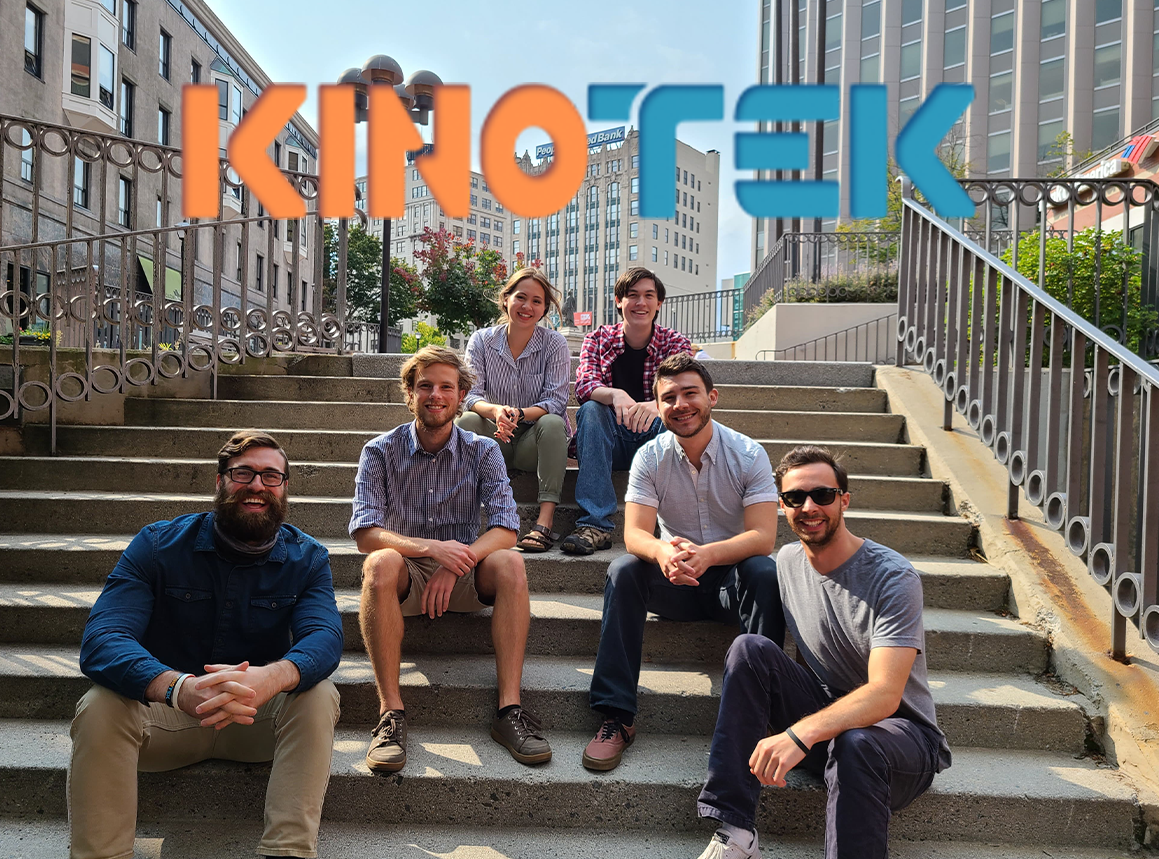Black Bear alumni, faculty, staff, and students are among Maine’s most productive innovators and entrepreneurs. This month, Innovators of UMaine showcases Justin Hafner ’18, CEO and co-founder of KinoTek, Inc. a Portland-based tech startup. KinoTek—pronounced Keen-o-tek—recently raised $600,000 in investor funding to develop 3D technology to aid healthcare providers. Read more.
A Queensbury, NY, native, Justin Hafner was still a UMaine undergraduate student majoring in kinesiology when he and fellow Black Bear David Holomakoff ’14, ’17G co-founded KinoTek in 2018. In a short period of time he and Holomakoff, the company’s chief product officer, added three more UMaine alumni to the team: Dan Lesko ’19 as chief technology officer; Eliza Bennett ’20 as creative director; and Adam Farrington ’20 as software engineer.
The company’s objective: to make movement analysis a mainstream approach for healthcare treatment and maintenance. Hafner explains.
“KinoTek’s goal is to empower clinicians with objective, visual, accessible movement data to improve patient care. We want doctors, physical therapists, chiropractors, sports clinicians, and occupational therapists to be able to more efficiently evaluate patients and communicate findings and treatment plans.”
BT: What’s your innovation?
Our Move.ly software [provides] real-time measurements of muscle activation, range of motion, and other metrics. Clinicians can visualize asymmetries and recognize potential risk areas — and share those findings with a patient immediately. The interface is clean, clear and easy for anyone to understand, which engages patients in their treatment and makes them more likely to comply.Clinicians can use the software to track and measure patient progress over time. We want to make movement analysis mainstream, which means helping clinicians and patients better understand human movement and use that knowledge to improve lives.
BT: What was your inspiration?
I started learning about virtual reality and 3D modeling while working at the VEMI Lab [a UMaine cross-disciplinary research facility that combines virtual-reality technologies with ideas from art, science, and engineering to create new ways to solve problems and serve needs]. I really got excited and started thinking there had to be a better way to learn kinesiology. I had this idea — I thought, ‘Oh man, if you put a VR headset on, you could learn anatomy and retain more skills.’
BT: How has your innovation changed since you first conceived it?
Our product has evolved quite a bit since the day I thought of it in Orono. We started out specifically looking to provide a solution for anatomy education. Once we realized we needed to think bigger, we shifted our focus to sports technology. When we shifted our focus to sports, we removed the VR features and aimed to create a software using wearable sensors.
Last spring, we were getting ready to launch with a product that provides coaches with an accurate way to assess their athletes’ body movement and provide an immersive user experience to instill confidence in an athlete returning to play from an injury. When COVID-19 struck, wearables were no longer a viable option. We established a partnership with Microsoft, and they introduced us to their next-generation computer vision camera. Once we realized we could use computer vision, we pivoted once more to healthcare. We now provide a solution that educates clients on their body movement, provides clinicians with previously inaccessible data, and ultimately improves quality of care.
BT: How will your innovation benefit people?
Our first product, Move.ly, will impact many lives. From our earliest users, we’re hearing how this product is a game changer because we can instantly provide insights that previously took hours, sometimes even days, all while improving the quality of care between the clinician and patient. We’re able to empower the everyday person to take control of the way they move and provide context to things they never considered. By disrupting the way people think about body movement, we’ll be able to prevent thousands of injuries — ultimately saving billions of dollars that would have gone to medical treatment — and improve the everyday person’s quality of life.
BT: How did your UMaine experience influence your innovation?
At [UMaine’s] Foster Center, I really learned how to bring a product to market — just the iterative process of customer discovery, product-market fit, all of these little things that are vital. The VEMI Lab taught me how to work with anyone and collaborate on a bunch of different projects, and provided the experience and the ability to explore my own research. [Enthusiastic support came from] Dr. Robert Lehnhard, director of the School of Kinesiology, Physical Education, and Athletic Training; VEMI Lab director Richard Corey; Jason Harkins, associate dean and associate professor of management at Maine Business School; and the team at the Foster Center for Innovation, including assistant vice president of innovation and economic development Renee Kelly, director of business incubation Veena Dinesh, and commercialization program professional Matt Hodgkin.
NOTE: The “Innovators of UMaine” series is supported by a grant to the Alumni Association from the Maine Technology Institute.
